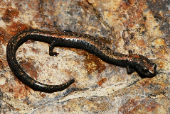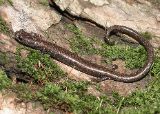 |
Kern Canyon Slender Salamander Range Map
|
|
|
 |
 |
 |
 |
 |
 |
 |
Kern Canyon Slender Salamander Juvenile
Want to Contribute a photo of a Juvenile Kern Canyon Slender Salamander?
Email Us
|
|
|
 |
 |
 |
 |
 |
 |
|
Kern Canyon Slender Salamander (Batrachoseps simatus)
Description: Adults are 1 5/8 to 2 1/5 inches long from snout to vent. A small slim salamander, with 20 to 21 costal grooves (with 7 to 9 costal folds between adpressed limbs.) Short limbs, a narrow head, long slender body, very long tail, and conspicuous costal and caudal grooves give this species the worm-like appearance typical of most Slender Salamanders. This species is relatively large and robust when compared with most Slender Salamanders, having a comparitively broader head, longer legs, broader feet, and larger toes. There are four toes on the front and hind feet, which is also typical of Slender Salamanders. (Other California salamanders have five toes on the hind feet.) The sides and ventral surfaces are dark, and flecked with a lighter color. There may be a dorsal stripe.
Habitat: Favored habitat is north-facing riparian zones in narrow canyons shaded with willows and cottonwoods and wooded hillsides supporting oaks and pines, including wet creek margins, seeps, talus, and exposed chaparral. These areas typically do not get sun in winter and remain moist and cool into the spring.
Range: Endemic to California. Batrachoseps simatus is found in the lower Kern River Canyon from Stork Creek, 1,476 feet to Erskine Creek, 3,937 feet. All known locality records appear to be from the south side (north face) of the canyon.
Found in these States:
CA
Diet: Probably eats a variety of small invertebrates. Feeding behavior is not well known, but other Batrachoseps species are sit-and-wait predators that use a projectile tongue to catch prey.
Reproduction: Reproduction is terrestrial. Nothing is known of the reproduction of B. simatus within Kern Canyon. Like other low to mid-elevation Batrachoseps, it is assumed that this species lays eggs on land between December and February, depending on stimulation by rainfall, which varies year to year. Young develop completely in the egg and hatch fully formed, presumbably in early spring.
Status: Listed as Endangered because its extent of occurrence (EOO) is 290 km2, it occurs in five or fewer threat-defined locations, and there is continuing decline in the extent and quality of its habitat.
»» Kingdom: Animalia - Animals
»» Phylum: Chordata - Chordates
»» Subphylum: Vertebrata - Vertebrates
»» Class: Amphibia - (Amphibians)
»» Order: Caudata - Salamanders
»» Family: Plethodontidae - Lungless Salamanders
»» Genus: Batrachoseps
»» Species: Batrachoseps simatus - Kern Canyon Slender Salamander
This article uses material from the Wikipedia article "Kern Canyon Slender Salamander", which is released under the Creative Commons Attribution-Share-Alike License 3.0. Content may have been omitted from the original, but no content has been changed or extended.
|
|











